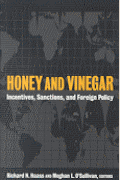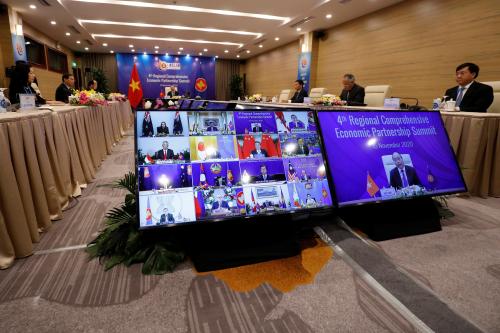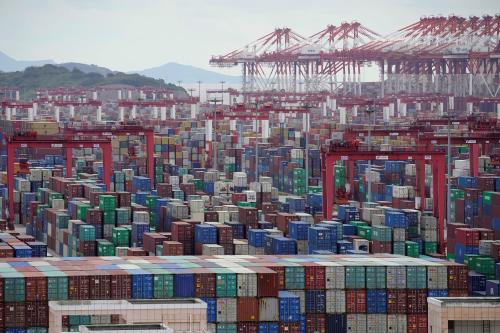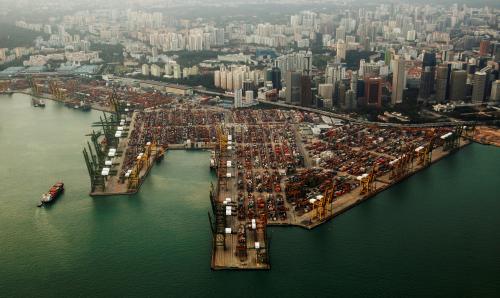In the aftermath of U.S. withdrawal from the Trans-Pacific Partnership (TPP) agreement, the U.S. strategy for economic engagement with Asia faces serious obstacles. American credibility is severely wounded. Across the region, confidence is low that the United States can negotiate trade agreements that will pass the domestic political test. At the same time, pervasive uncertainty about the new “America First” trade policy is inhibiting prospective partners from engaging in bilateral trade negotiations.
The perception and reality of a diminished American presence in Asia is encouraging countries in the region to hedge by seeking closer cooperation with China. By and large, Asian governments remain convinced that multiparty trade agreements yield the most economic and geopolitical benefits, and several mega trade agreements that do not include the United States are in development—notably the China-backed Regional Comprehensive Economic Partnership (RCEP), the Japan-E.U. Free Trade Agreement (FTA), and TPP11, an effort by the remaining TPP signatories to sustain the agreement in some form. Meanwhile, China has stepped up its game in the field of development finance with the successful rollout of the Asian Infrastructure Investment Bank (AIIB) and the launch of its One Belt, One Road (OBOR) initiative. In the arena of economic diplomacy, Asians appear to be moving on without the United States.
President Trump’s upcoming trip to Asia presents an opportunity for the administration to address this growing uncertainty and take steps to stabilize and enhance U.S. economic engagement with Asia. Here, we offer a series of recommendations on how this can be accomplished.
Articulate a Vision
The first priority should be to articulate the goals that will guide U.S. engagement. All countries in the region are trying to understand the changing parameters of U.S. foreign economic policy under this administration. Reducing their doubts and uncertainty will increase the chances we can pursue concrete initiatives that will create reciprocal benefits. In keeping with this approach, the administration should foster win-win economic relations with countries in the region, and prevent U.S. marginalization from the evolving regional economic architecture.
We should also compete with China, constructively. The goals here are manifold: to encourage domestic Chinese reforms, offer alternative economic integration options to Asian nations, and to disseminate high-standards of trade and investment liberalization that leverage the areas of comparative advantage for the American economy (agriculture, advanced manufacturing, e-commerce, services, and intellectual property to name a few).
Implement a Strategy
To achieve this vision, we recommend that the following action items be carried out on two levels: foreign economic policy and the related domestic political agenda.
Foreign Economic Policy
Complete ongoing trade renegotiations in a productive and timely way. Through the NAFTA redo and amendments to the South Korea-United States (KORUS) free trade agreement (FTA), the administration has an opportunity to modernize an older trade agreement and ensure effective implementation of commitments in a more recent one. Successful completion of these renegotiations will clarify to our prospective partners what has changed, or not, under an America First trade policy; it will also inform their decisions on the merits about whether to negotiate bilaterally with the United States. The road to a credible trade strategy for Asia starts with the survival of NAFTA.
The road to a credible trade strategy for Asia starts with the survival of NAFTA.
Relaunch BIT negotiations with China. The U.S. and China have gotten close to agreement on the language of a bilateral investment treaty (BIT), but important negotiations remain on the details of the list of exempted sectors. It will not be easy to reach an agreement, but continuing the negotiation is important. Many of the high-tech and service sectors in which U.S. exports are strong require foreign direct investment in China for our firms to operate successfully. Hence, the BIT is an important trade issue. BIT negotiation should be part of a larger strategy to encourage China to open up its economy. Our partners in Asia also closely follow the negotiations—they want to see Washington continuing to engage and taking the lead in pushing China to be more open. Putting the BIT on the back burner plays into the narrative that the United States is withdrawing from Asia and leaving the field to the Chinese.
Reform Multilateral Development Banks (MDBs). Work with Japan and other shareholders to reform the Asian Development Bank (ADB) and World Bank to make these multilateral development organizations more agile in their lending operations, as well as more attractive to potential clients in light of greater competition through the lending of China’s policy banks and the establishment of AIIB. China is lending about $60 billion per year for infrastructure in developing countries, far beyond what the World Bank and ADB are doing. OBOR is the brand, but the effort in fact is global with much of the lending going to Africa. Most of the lending so far has come from China Development Bank and the China Export-Import Bank, but AIIB is off to a fast start as a new competitor in this area. Even many democratic and well-managed countries are turning to China for finance because the existing development banks lack sufficient resources and are mired in regulation and bureaucracy. A U.S.-led effort to expand and reform the MDBs would be very welcome in the developing world and would provide options in addition to what China is offering.
Partner with Japan in Southeast Asia. Establish a partnership with Japan on economic cooperation projects in Southeast Asia. Tokyo responded to the establishment of AIIB by launching its own Quality Infrastructure Fund and has a longstanding presence in the region through its overseas economic assistance programs. This offers an opportunity to marry funding with expertise in countries like Vietnam and Myanmar. For instance, Japan is Vietnam’s largest bilateral donor, largest foreign investor, and one of its biggest trading partners. The United States could develop trilateral cooperation with Japan and Vietnam to sustain a strong geo-economic position in Southeast Asia in the face of China’s assertive economic diplomacy in the region. Aside from infrastructure, this cooperation could promote climate resilient development in the Mekong Delta.
Double-down on U.S.-ASEAN Connect. Taken together, the ten countries that comprise the Association of Southeast Asian Nations, or ASEAN, boast the third-largest population in the world and a GDP of $2.4 trillion. Trade between the United States and ASEAN totals about $275 billion annually, and U.S. businesses are the largest cumulative source of foreign direct investment in the regional grouping. However, most of this trade and investment is concentrated in three countries—Singapore, Malaysia, and Thailand—and U.S. companies occupy only a small share of key emerging markets such as energy infrastructure. Created last year as a U.S. government initiative, U.S.-ASEAN Connect has thus far established centers in Jakarta, Singapore, and Bangkok to coordinate and expand U.S. economic engagement in the region and facilitate networking among policymakers, entrepreneurs, and businesses. These centers aim to become one-stop-shops for different U.S. stakeholders doing business in the region. The administration should highlight this initiative during the president’s upcoming visits to Vietnam and the Philippines, and consider setting up additional centers in Ho Chi Minh City, Manila, and other ASEAN capitals or commercial centers.
Complementary Domestic Agenda
Engage Congress. On the domestic side, it will be crucial to engage Congress and other U.S. stakeholders, particularly the business community and related trade associations, to build support coalitions in favor of such an Asia economic engagement strategy. This will be key to reassuring counterparts in the region that the range of bilateral economic initiatives that require congressional ratification have strong and sustainable domestic support in the American political system.
Build domestic social resilience to cope with fast economic change.Worker retraining programs in different platforms (e.g., community college certifications and apprenticeships), as well as expanded labor adjustment programs, will leave the American workforce better prepared to deal with the faster pace of economic change. Skills retraining will be particularly important, with curricula ideally designed with employers in mind. They will also provide a domestic foundation for international economic engagement.
By implementing the above steps, the administration would reduce the uncertainty that is currently discouraging our counterparts in Asia from embarking on a new set of bilateral initiatives that the current administration favors. These steps would also boost the credibility of U.S. economic strategy in the region and prevent a vacuum from developing that encourages hedging by others through closer alignment with China. Ideally, the administration could signal or announce support for these economic initiatives either just before or during the President’s upcoming trip to Asia, including in his planned speech at the APEC CEO Summit in Danang, Vietnam on November 10. This will maximize impact and provide confidence in U.S. staying power, demonstrating that the United States is a Pacific nation and is committed to the region for the long run.










Commentary
Rescuing U.S. economic strategy in Asia
October 25, 2017